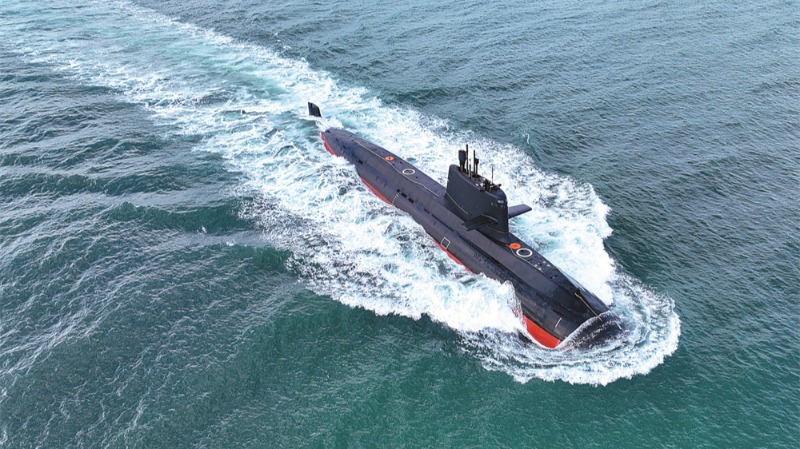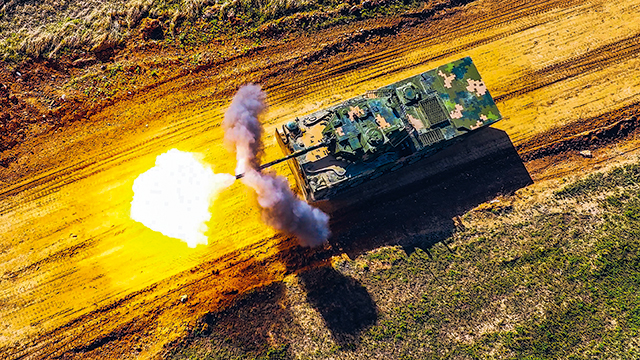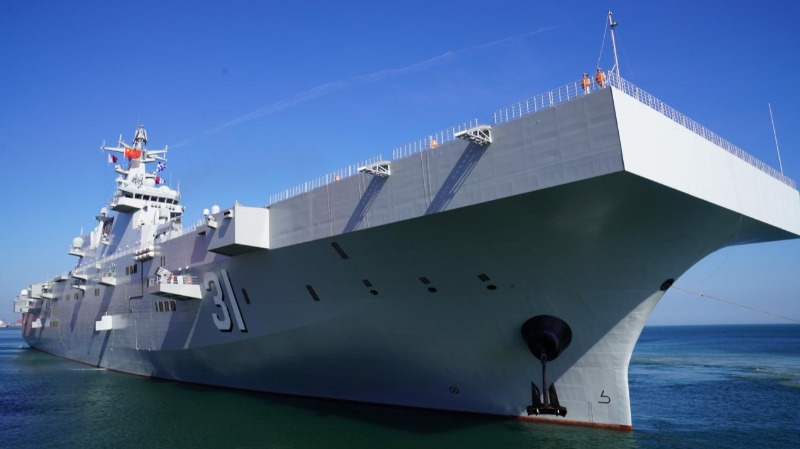By Peng Nian
彭念
美国副国务卿谢尔曼近日对东南亚国家展开访问,她访问柬埔寨时对所谓“中国在柬建立军事设施”表达“严正关注”,意图掀起新一轮炒作。渲染这一议题的背后是美方盘算将“军事威胁”塑造成又一个抹黑中国的工具。
During her visit to Cambodia, US Deputy Secretary of State Wendy Sherman expressed “serious concerns” about China’s "military presence and construction of facilities" in Cambodia, obviously trying to arouse a new round of hype of the so-called “military threat” from China, a topic that the US side is racking its brains to use as a new China-smearing tool.
实际上,所谓的“中国在柬建军事设施”前因后果非常清楚。起因是柬埔寨在2019年拆除了由美国出资兴建的云壤海军基地内两栋存放小型巡逻艇的建筑,美国借此怀疑中国军队趁机进驻,于是向柬埔寨进行外交施压,要求柬埔寨做出解释,并提出继续由美国出资修建新的军事设施,但遭到柬埔寨的婉拒。
It’s very clear why Sherman would be so interested in the so-called “Chinese military facilities in Cambodia”. Cambodia demolished two US-funded buildings at the Ream Naval Base in 2019, which made the US suspect that Chinese troops would station there and demanded an explanation from Cambodia through ramping up diplomatic pressure. Its suggestion to fund new military facilities in the country was also declined.
美国为此更加担心“中国染指云壤海军基地”。2020年1月,美国派遣驻柬使馆武官亲赴云壤海军基地探查实情,结果一无所获。可美方依然不甘心,在2020年9月借对中国优联集团实施制裁之际,称其在柬埔寨西南海岸的七星海度假村项目“可能用来存放中国军事资产”,继续炒作中国在柬埔寨建军事设施。
This made the US even more worried about China’s involvement at the Ream Naval Base. In January 2020, it sent its military attaché to the American embassy in Cambodia to inspect the base personally, which yielded nothing. Refusing to accept this result, the US side, taking advantage of its sanctions against China’s Union Development Group Co., Ltd. (UDG) in September 2020, claimed that its Dara Sakor development project on the southwest coast of Cambodia might be used to keep Chinese military assets, keeping hyping up "China’s construction of military facilities" in the country.
此次谢尔曼访柬重提“中国在柬建军事设施”,一方面是想继续对柬施压,另一方面意在渲染中国对东南亚国家的“军事威胁”,离间中国与东南亚国家的友好关系。而且,美国专挑与中国关系密切的国家下手,以最为敏感的军事设施作为炒作话题,以威胁国家主权和地区安全为主要借口,试图以此破坏中国的海外形象,激起这些国家对中国的恐惧之心。
Mentioning this topic during Sherman’s visit was to keep up the pressure on Cambodia on the one hand and exaggerate so-called "China’s military threat" to Southeast Asian countries on the other, aiming to disrupt their friendly relations with China. The US primarily targets countries in close ties with China and focuses on the most sensitive topic of military facilities, which it claims threaten national sovereignty and regional security, with the sinister intention of sabotaging China’s image overseas and planting fear in those countries for China.
此外,美国之所以对渲染“中国海外军事设施”如此上心,一个重要原因还在于美国对中国海外影响力扩大的焦虑。近年来,美国在全球的军事设施和军事基地呈现出逐步“萎缩”状态,而中国对外基础设施合作稳步推进,海外影响力有所提升。这相对的一降一升放大了美国的对华焦虑。
Another important reason why the US is so bent on hyping up "China’s military facilities overseas" is that it is vexed by China’s increased influence overseas. In recent years, America’s global military facilities and bases have kept shrinking, whereas China’s international infrastructure cooperation steadily gains ground with rising overseas influence. The contrast has augmented America’s anxiety over China.
近年来,随着东南亚国家对美国主动挑起对华军事竞争的不满,美国在东南亚的军事基地和设施愈发不受欢迎。比如,菲律宾总统杜特尔特曾指示暂停菲美《访问部队协议》,以提升菲律宾军队的自主性。在这种情况下,美国不仅通过威逼,还希望以利诱的方式,尽力保住其在东南亚的军事设施,维持其在东南亚的军事优势。谢尔曼在此次访问柬埔寨时,就主动提到柬埔寨在上世纪70年代欠下的美国债务(如今连本带利约6亿美元),强调美方愿同柬政府在“免除旧债”议题上进行合作。目的就是希望柬埔寨方面恢复、加强与美国的关系。
America’s military bases and facilities in southeast Asian countries have become increasingly unpopular in recent years as the latter is dissatisfied with America’s initiation of the anti-China military competition. For instance, to build a Philippine military,President Rodrigo Duterte once ordered the abrogation of the bilateral Visiting Forces Agreement (VFA) with the US. Under such circumstances, the US has been trying all means, be it pressuring, intimidation or coaxing, to maintain its military facilities and superiority in Southeast Asia. During her visit to Cambodia this time, Sherman mentioned the debts Cambodia owed the US in the 1970s, which amounts to USD 600 million today interests included, and emphasized Washington’s willingness to work with the Cambodian government on the exemption of old debts, as bait for Cambodia to resume and reinforce its relations with the US.
实际上,包括柬埔寨在内的部分东南亚国家都在宪法中有明文规定,不允许外国驻军,想必美国心知肚明。并且,柬埔寨首相洪森曾数次公开辟谣,柬方表示中国只是资助修建船舶修理设施,并无任何军事企图,甚至同意美方人员和记者参观。但美国依然选择视而不见,可见其在这个问题上的地缘战略用心。
As a matter of fact, it is stated in the constitutions of some southeast Asian countries, including Cambodia, that no foreign troops are allowed on their territory, which the US is well aware of. Cambodian Prime Minister Hun Sen has publicly clarified several times that China only funds the construction of ship-repairing facilities and has no military agenda in the country; he even allowed American personnel and reporters to visit the facilities, but the US chose to turn a blind eye to all the facts and evidence, which reveals its geostrategic purpose on this issue.
可以说,美国一些人把中国与东南亚国家正常的基础设施合作项目,往“军事设施”方向炒作,用心是非常险恶的。其目的是逼迫东南亚一些国家放弃与中国的相关合作项目或与中国进行合作时有所顾忌,从而破坏中国在海外建设港口等基础设施合作项目的正常推进。
It is malicious of some Americans to portray normal infrastructure cooperation between China and Southeast Asian countries from a military perspective. They are just trying to force those countries to give up their cooperation projects with China or have doubts and concerns when working with it, thus obstructing China’s overseas port construction and other infrastructure cooperation.
(作者是中国南海研究院海上丝绸之路研究所副所长)
(The author is deputy director & associate fellow of the Research Center of Maritime Silk Road, National Institute for South China Sea Studies, China) Editor’s note: This article is originally published on huanqiu.com.cn, and is translated from Chinese into English and edited by the China Military Online. The information, ideas or opinions appearing in this article do not necessarily reflect the views of eng.chinamil.com.cn.


















